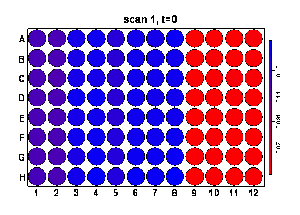Using R to process Plate Data
R is good for reading, processing, and re-arranging data from 96 or 384 well plates. Often plate readers generate data which resembles the following:
Example
[Plate: M 410 #1] Time=00:00:00 ;1;2;3;4;5;6;7;8;9;10;11;12 A;0.125;0.123;0.145;0.148;0.138;0.146;0.145;0.150;0.049;0.050;0.050;0.052 B;0.124;0.123;0.144;0.147;0.137;0.147;0.146;0.147;0.050;0.051;0.050;0.051 C;0.123;0.122;0.145;0.145;0.137;0.147;0.147;0.148;0.050;0.051;0.052;0.051 D;0.123;0.123;0.149;0.150;0.137;0.148;0.146;0.147;0.050;0.050;0.051;0.050 E;0.123;0.123;0.145;0.147;0.137;0.148;0.148;0.147;0.050;0.050;0.051;0.051 F;0.123;0.123;0.148;0.149;0.140;0.148;0.148;0.149;0.049;0.051;0.050;0.050 G;0.123;0.123;0.143;0.150;0.139;0.149;0.149;0.150;0.051;0.051;0.050;0.051 H;0.125;0.123;0.146;0.152;0.140;0.151;0.150;0.154;0.050;0.051;0.050;0.051 [Plate: M 410 #2] Time=00:01:00 ;1;2;3;4;5;6;7;8;9;10;11;12 A;0.125;0.123;0.174;0.176;0.154;0.174;0.173;0.178;0.050;0.050;0.050;0.052 B;0.124;0.123;0.172;0.174;0.153;0.173;0.172;0.176;0.051;0.051;0.050;0.052 C;0.124;0.123;0.174;0.171;0.151;0.172;0.172;0.176;0.050;0.051;0.052;0.051 D;0.124;0.124;0.180;0.179;0.152;0.173;0.172;0.175;0.050;0.051;0.051;0.051 E;0.124;0.124;0.175;0.175;0.153;0.173;0.174;0.174;0.051;0.051;0.051;0.051 F;0.123;0.124;0.178;0.178;0.156;0.174;0.173;0.177;0.050;0.051;0.050;0.051 G;0.123;0.124;0.170;0.178;0.156;0.175;0.176;0.178;0.051;0.051;0.050;0.051 H;0.125;0.124;0.175;0.181;0.157;0.179;0.177;0.184;0.050;0.051;0.050;0.051 [...] etc.
Data such as the above in a text file can be read into R using read.table(), and with some re-arrangement visualized the the prada library.
|
